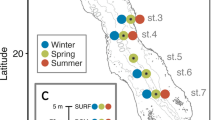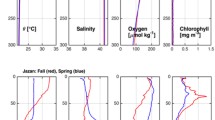Abstract
The richness and biogeographical distribution pattern of bacterial and archaeal communities was assessed by terminal restriction fragment length polymorphism analysis of polymerase chain reaction-amplified fragments of the 16S rRNA gene at the surface (15–25 m depth), in the deep chlorophyll maximum layer (DCM; 50 m depth), and deep waters (75–1000 m depth) of the eastern tropical Atlantic Ocean. Additionally, prokaryotic and viral abundance and the frequency of infected prokaryotic cells (FIC) were determined along with physico-chemical parameters to identify factors influencing prokaryotic richness and biogeography. Viral abundance was highest in the DCM layer averaging 45.5 × 106 ml−1, whereas in the mixed surface layer and in the waters below the DCM, average viral abundance was 11.3 × 106 and 4.3 × 106 ml−1, respectively. The average estimate of FIC was 8.3% in the mixed surface layer and the DCM and 2.4% in deeper waters. FIC was positively related to prokaryotic and viral abundance and negatively to archaeal richness. There was no detectable effect of geographic distance (maximum distance between stations ∼4600 km) or differences between water masses on bacterial and archaeal community composition. Bacterial communities showed a clear depth zonation, whereas changes in archaeal community composition were related to temperature and FIC. The results indicate that planktonic archaeal virus host systems are a dynamic component of marine ecosystems under natural conditions.


Similar content being viewed by others
References
Bouvier T, del Giorgio PA (2007) Key role of selective viral-induced mortality in determining marine bacterial community composition. Environ Microbiol 9:287–297
de Wit R, Bouvier T (2006) ‘Everything is everywhere, but, the environment selects’; what did Baas Becking and Beijerinck really say? Environ Microbiol 8:755–758
DeLong EF (1992) Archaea in coastal marine environments. Proc Natl Acad Sci U S A 89:5685–5689
DeLong EF, Preston CM, Mincer T, Rich V, Hallam SJ, Frigaard N-U, Martinez A, Sullivan MB, Edwards E, Rodriguez BB, Chisholm SW, Karl DM (2006) Community genomics among stratified microbial assemblages in the ocean’s interior. Science 311:496–503
Fuhrman JA, Davis AA (1997) Widespread Archaea and novel Bacteria from the deep sea as shown by 16S rRNA gene sequences. Mar Ecol Prog Ser 150:275–285
Herndl GJ, Reinthaler T, Teira E, van Aken H, Veth C, Pernthaler A, Pernthaler J (2005) Contribution of Archaea to total prokaryotic production in the deep Atlantic Ocean. Appl Environ Microbiol 71:2303–2309
Hewson I, Fuhrman JA (2007) Covariation of viral parameters with bacterial assemblage richness and diversity in the water column and sediments. Deep-Sea Res I 54:811–830
Hewson I, Winget DM, Williamson KE, Fuhrman JA, Wommack KE (2006) Viral and bacterial assemblage covariance in oligotrophic waters of the West Florida Shelf (Gulf of Mexico). J Mar Biol Ass UK 86:591–603
Hughes Martiny JB, Bohannan BJM, Brown JH, Colwell RK, Fuhrman JA, Green JL, Horner-Devine MC, Kane M, Krumins AA, Kuske CR, Morin PJ, Naeem S, Øvreås L, Reysenbach A-L, Smith VH, Staley JT (2006) Microbial biogeography: putting microorganisms on the map. Nature Rev Microbiol 4:102–112
Ingalls AE, Shah SR, Hansman RL, Aluwihare LI, Santos GM, Druffel ERM, Pearson A (2006) Quantifying archaeal community autotrophy in the mesopelagic ocean using natural radiocarbon. Proc Natl Acad Sci U S A 103:6442–6447
Karner MB, DeLong EF, Karl DM (2001) Archaeal dominance in the mesopelagic zone of the Pacific Ocean. Nature 409:507–510
Lane DJ (1991) 16S/23S rRNA sequencing. In: Stackebrandt E, Goodfellow M (eds) Nucleic acid techniques in bacterial systematics. Wiley, New York, pp 115–176
Legendre P, Legendre L (1998) Numerical ecology, 2nd edn. Elsevier, Amsterdam, The Netherlands
López-García P, López-López A, Moreira D, Rodríguez-Valera F (2001) Diversity of free-living prokaryotes from a deep-sea site at the Antarctic Polar Front. FEMS Microbiol Ecol 36:193–202
Mantel N (1967) The detection of disease clustering and a generalized regression approach. Cancer Res 27:209–220
Massana R, DeLong EF, Pedrós-Alió C (2000) A few cosmopolitan phylotypes dominate planktonic archaeal assemblages in widely different oceanic provinces. Appl Environ Microbiol 66:1777–1787
Moeseneder MM, Winter C, Arrieta JM, Herndl GJ (2001a) Terminal-restriction fragment length polymorphism (T-RFLP) screening of a marine archaeal clone library to determine the different phylotypes. J Microb Methods 44:159–172
Moeseneder MM, Winter C, Herndl GJ (2001b) Horizontal and vertical complexity of attached and free-living bacteria of the eastern Mediterranean Sea, determined by 16S rDNA and 16S rRNA fingerprints. Limnol Oceanogr 46:95–107
Murray AE, Preston CM, Massana R, Taylor LT, Blakis A, Wu K, DeLong EF (1998) Seasonal and spatial variability of bacterial and archaeal assemblages in the coastal waters near Anvers Island, Antarctica. Appl Environ Microbiol 64:2585–2595
Murray AG, Jackson GA (1992) Viral dynamics: a model of the effects of size, shape, motion and abundance of single-celled planktonic organisms and other particles. Mar Ecol Prog Ser 89:103–116
Noble RT, Fuhrman JA (1998) Use of SYBR Green I for rapid epifluorescence counts of marine viruses and bacteria. Aquat Microb Ecol 14:113–118
Ouverney CC, Fuhrman JA (2000) Marine planktonic archaea take up amino acids. Appl Environ Microbiol 66:4829–4833
Sambrook J, Russell DW (2001) Molecular cloning: a laboratory manual. Cold Spring Harbor Laboratory Press, New York
Schwalbach MS, Hewson I, Fuhrman JA (2004) Viral effects on bacterial community composition in marine plankton microcosms. Aquat Microb Ecol 34:117–127
Teira E, von Aken H, Veth C, Herndl GJ (2006a) Archaeal uptake of enantiomeric amino acids in the meso- and bathypelagic waters of the North Atlantic. Limnol Oceanogr 51:60–69
Teira E, Lebaron P, van Aken H, Herndl GJ (2006b) Distribution and activity of Bacteria and Archaea in the deep water masses of the North Atlantic. Limnol Oceanogr 51:2131–2144
Thingstad TF (2000) Elements of a theory for the mechanisms controlling abundance, diversity, and biogeochemical role of lytic bacterial viruses in aquatic systems. Limnol Oceanogr 45:1320–1328
Thingstad TF, Lignell R (1997) Theoretical models for the control of bacterial growth rate, abundance, diversity and carbon demand. Aquat Microb Ecol 13:19–27
Weinbauer MG (2004) Ecology of prokaryotic viruses. FEMS Microbiol Rev 28:127–181
Weinbauer MG, Winter C, Höfle MG (2002) Reconsidering transmission electron microscopy based estimates of viral infection of bacterioplankton using conversion factors derived from natural communities. Aquat Microb Ecol 27:103–110
Winter C, Moeseneder MM, Herndl GJ (2001) Impact of UV radiation on bacterioplankton community composition. Appl Environ Microbiol 67:665–672
Winter C, Smit A, Herndl GJ, Weinbauer MG (2004) Impact of virioplankton on archaeal and bacterial community richness as assessed in seawater batch cultures. Appl Environ Microbiol 70:804–813
Winter C, Smit A, Herndl GJ, Weinbauer MG (2005) Linking bacterial richness with viral abundance and prokaryotic activity. Limnol Oceanogr 50:968–977
Wuchter C, Abbas B, Coolen MJL, Herfort L, von Bleijswijk J, Timmers P, Strous M, Teira E, Herndl GJ, Middelburg JJ, Schouten S, Damsté JSS (2006) Archaeal nitrification in the ocean. Proc Natl Acad Sci U S A 103:12317–12322
Wuchter C, Schouten S, Boschker HTS, Damsté JSS (2003) Bicarbonate uptake by marine Crenarchaeota. FEMS Microbiol Lett 219:203–207
Acknowledgments
We thank the captain and crew of R/V Pelagia for their support at sea. We are grateful to G. J. Brummer for the opportunity to join the cruise. We would like to thank three anonymous reviewers for their helpful comments. Funding was provided by the Dutch Science Foundation (NWO-ALW grant 809.33.004) and the Royal NIOZ. Preparation of the manuscript was supported by a Marie Curie postdoctoral fellowship to CW (project ILVIROMAB, no. 007712).
Author information
Authors and Affiliations
Corresponding author
Rights and permissions
About this article
Cite this article
Winter, C., Moeseneder, M.M., Herndl, G.J. et al. Relationship of Geographic Distance, Depth, Temperature, and Viruses with Prokaryotic Communities in the Eastern Tropical Atlantic Ocean. Microb Ecol 56, 383–389 (2008). https://doi.org/10.1007/s00248-007-9343-x
Received:
Accepted:
Published:
Issue Date:
DOI: https://doi.org/10.1007/s00248-007-9343-x




